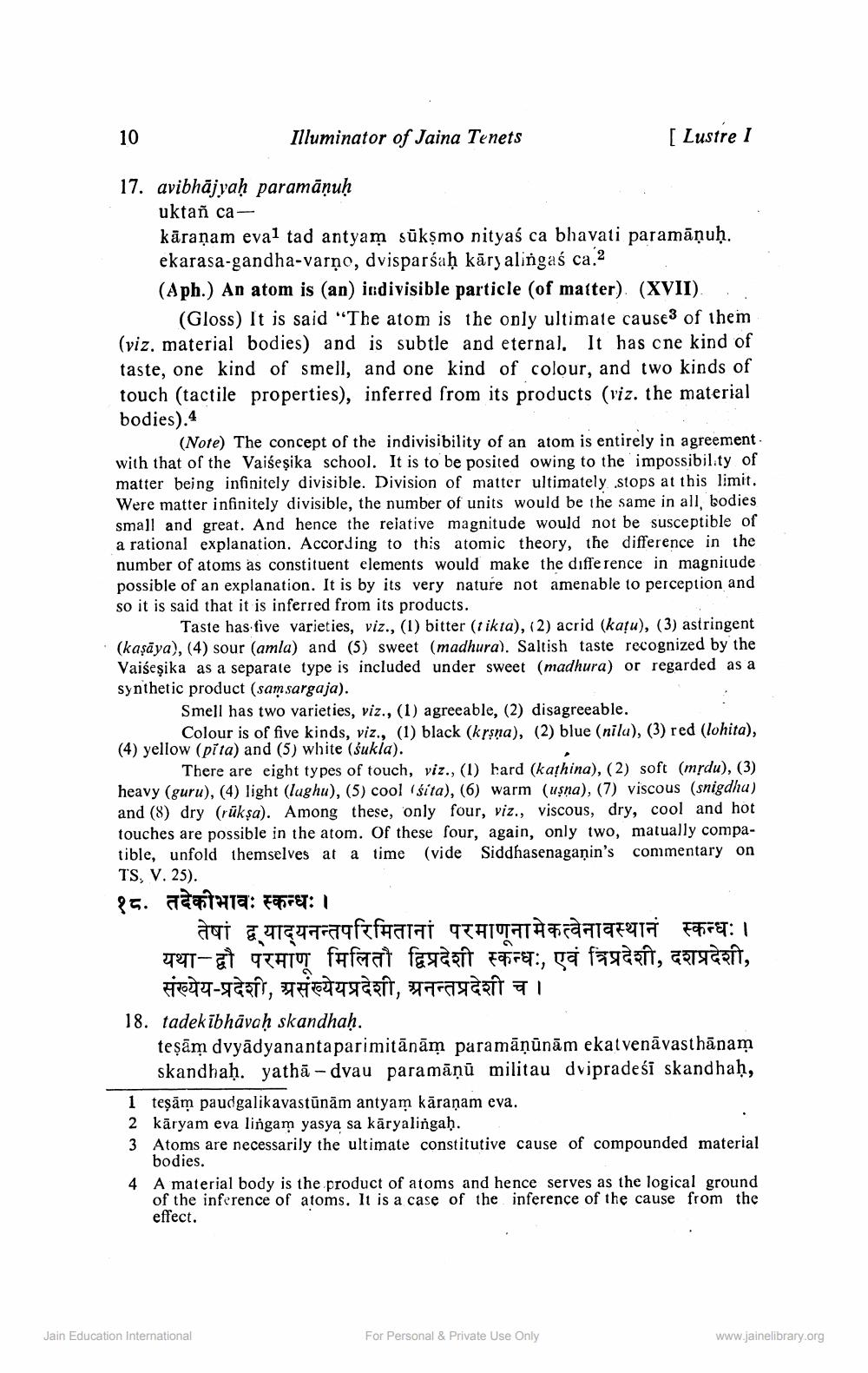________________
10
Illuminator of Jaina Tenets
17. avibhājyaḥ paramānuḥ
uktañ ca
kāraṇam eva1 tad antyam sukṣmo nityaś ca bhavati paramāņuḥ. ekarasa-gandha-varno, dvisparśaḥ kāryalingas ca.2
[ Lustre I
(Aph.) An atom is (an) indivisible particle (of matter) (XVII)
(Gloss) It is said "The atom is the only ultimate cause of them (viz. material bodies) and is subtle and eternal. It has one kind of taste, one kind of smell, and one kind of colour, and two kinds of touch (tactile properties), inferred from its products (viz. the material bodies).4
(Note) The concept of the indivisibility of an atom is entirely in agreement. with that of the Vaiseṣika school. It is to be posited owing to the impossibility of matter being infinitely divisible. Division of matter ultimately stops at this limit. Were matter infinitely divisible, the number of units would be the same in all, bodies small and great. And hence the relative magnitude would not be susceptible of a rational explanation. According to this atomic theory, the difference in the number of atoms as constituent elements would make the difference in magnitude. possible of an explanation. It is by its very nature not amenable to perception and so it is said that it is inferred from its products.
Taste has five varieties, viz., (1) bitter (tikta), (2) acrid (kațu), (3) astringent (kaşaya), (4) sour (amla) and (5) sweet (madhura). Saltish taste recognized by the Vaiśeşika as a separate type is included under sweet (madhura) or regarded as a synthetic product (samsargaja).
Smell has two varieties, viz., (1) agreeable, (2) disagreeable.
Colour is of five kinds, viz., (1) black (kṛṣṇa), (2) blue (nila), (3) red (lohita), (4) yellow (pita) and (5) white (sukla).
There are eight types of touch, viz., (1) hard (kathina), (2) soft (mrdu), (3) heavy (guru), (4) light (laghu), (5) cool (śita), (6) warm (uşṇa), (7) viscous (snigdha) and (8) dry (rükşa). Among these, only four, viz., viscous, dry, cool and hot touches are possible in the atom. Of these four, again, only two, matually compatible, unfold themselves at a time (vide Siddhasenaganin's commentary on TS, V. 25).
१८. तदेकीभावः स्कन्धः ।
तेषां द्वयाद्यनन्तपरिमितानां परमाणूनामेकत्वेनावस्थानं स्कन्धः । यथा - द्वौ परमाणू मिलितौ द्विप्रदेशी स्कन्धः, एवं त्रिप्रदेशी, दशप्रदेशी, संख्येय-प्रदेशी, असंख्येयप्रदेशी, अनन्तप्रदेशी च ।
18. tadekibhavaḥ skandhaḥ.
teṣām dvyādyanantaparimitānām paramāṇūnām ekat venävasthanam skandhaḥ. yatha - dvau paramāņu militau dvipradeśī skandhaḥ,
1 teṣām paudgalikavastūnām antyam kāraṇam eva.
2 karyam eva lingam yasya sa kāryalingaḥ.
3 Atoms are necessarily the ultimate constitutive cause of compounded material bodies.
Jain Education International
4 A material body is the product of atoms and hence serves as the logical ground of the inference of atoms. It is a case of the inference of the cause from the effect.
For Personal & Private Use Only
www.jainelibrary.org




